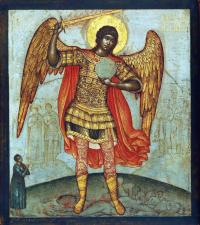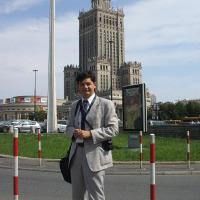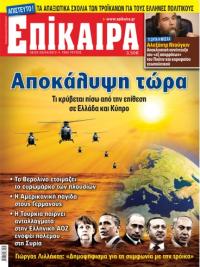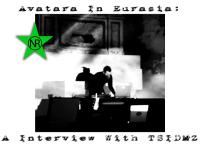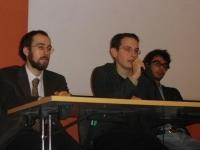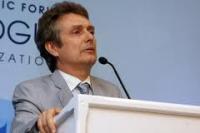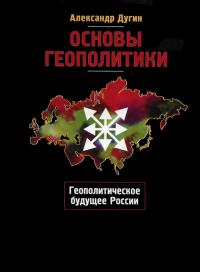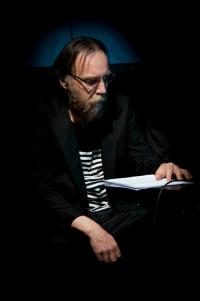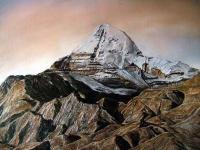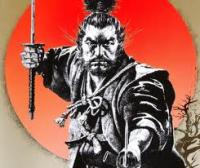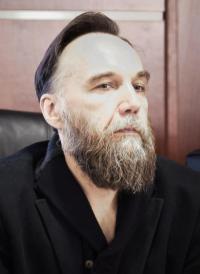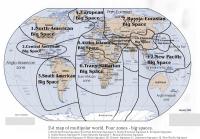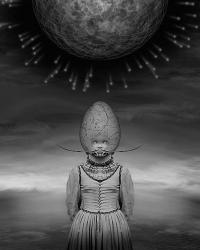Eurasianism
Russia, the motherland of Archangel
The Russian Archangel, whose external expression are Russian borders, and internal content is the religious community of Russian theoforic (God-bearing people), is the last obstacle for the "son of abomination." This is the eschatological mission of Russia, which, even under the red flag, under the yoke of materialistic doctrines fabricated by " wells’ guards of the West", protected nevertheless mankind from the last phase of its history. Even the red beast of communism was precisely a beast of the East, a monstrous grin of lower layers of the soul, but it was the soul, alive, vibrating, passionate, deep, anointed be the Russian mystery, by the Russian grace, having drunk the live moisture of resurrection. Yet, for comparison with the great Russian suffering, with the suffering of the Archangel, "with the suffering of the East" even wellness and prosperity of "the western wells" is an unbearable torture at least for those who are anointed with the life-giving spirit of Russia, who is bitten by its light-bearing sadness and its dark joy. While there is Russia, there is the Church, there is the faith, there is the life. While there is Russia, there is "the one who now holds it back will continue to do so till he is taken out of the way." While there is Russia,"katehon" of soul keeps the "son of abomination" out from the accomplishing last eschatological evil deed, there is no chance for the antichrist to begin its fetid sermon, a sermon "of comfort and well-being prevailing in the bottom of the wells of the western exile."
To build a real Eurasia: few juridical ideas
Trying to speak about continental political constructions, we need to understand their limits. Inside all human institutions there is a limit, because the possibility to create something able to satisfy always all interest is impossible.
In this case, we must look to the theories. All of them underline that in the moment when few great people want to introduce big ideas on public debate, a lot of critics will appear, not trying to accept and correct the positive aspects of these activities, but only speaking about the limits (economics, politics, human relations, etc.).
Eurasia is a big idea only if we want to thing to it; more than that – is a big idea if someone will try to explain this to the world. However, the dimension of these continents is huge, and a scientist will see easier the limits of this construction. And, when human society will be prepared, it could be a possibility to create a new European, maybe, after European Union model.
Oblivion and Discourse of Being
"In the caves which were used as primitive habitat, the so-called cavemens, were found rock drawings, ornaments which show the strange creative power and even weirder creative perception of those who created them. Movements of animals in the jump) – buffalo, deer, etc... – confirmed in modern science with the using of the the current photographic technics, show such precision in the eye of the primary artists which forcibly impose belief that their visual power was much stronger than is ours, which is primarily synthetic, so we're practically not able to observe a movement separated from the movement, which he follows, while, for the population of the cave, that was quite normally experience. There is also observed that those painting fragments are found in the deep cave, where is total darkness, and where we could work only with the artificial light, while in those places is not find any remaining of the smoke and soot, whose tracks had to stay there, because the torches and oil lamps of that time had to smoke, sam as today ones. They, therefore, were able to see in that, for modern humans, darkness, more clearly and they felt the need for coloring, drawing for which eye request even more light" (Rastko Petrovic: „A primitive civilization which became extinct“).
The Big Game – and its Greek and Cypriot “chapter”
First of all we should remember the immense role of Greece in Russian identity. Greece has given us almost all – faith, alphabet (prepared for us by two Greek Saints - Saint Cyril and Saint Matthew), culture,cosmic vision, political concept of Orthodox Empire (the Byzantine as an example), social ideal (κοινωνία), philosophy, law… The same could be said about all Europeans, but our ties are deeper and more organic and direct. So we Russians are absolutely indebted to the Greeks.
But in the course of history Greeks and Russians have seen different dramatic turns. Sometimes we were together (in faith we were and are brothers), sometimes separately… It is difficult in the course of an interview to make the sufficient survey of all these turns – let’s concentrate on the most important ones…
New paradigm of science (Tokyo University)
The rational man, the man who bases his perception of the world on the "common sense" ("la bonne raison", "bon sens" or "la bonne foi") is the subject of the modern science , its self, its creator, its main developer. In the pre-scientifical period such a subject did not exist purely or, at least, it did not claim for the rational approach as the only one to formulate the truths of the surrounding reality's nature. Some certain superrational dogmas and myths always prevailed over the rational man. As to science, it set itself to emancipation from non-rational foundations from the very beginning. And this is just what one of its specific distinctive features consists in. Where this criterion is not observed, we cannot talk about the science in the strict (modern) sense of that word and should use other formulas, such as "pre-scientific conceptions", "para-scientific method", "pre-scientific" and in some situations even "post-scientific" approaches.
Establish a multipolar world order
In my opinion, a multipolar world is the order with 5 or more centers of power in the world and this reality will keep our planet more safe and balanced with shared responsibility between the regions. But it is not just interdependence by the logic of liberalism: some regions might well exist in relative political and economic autarky. Beside that, there might exist a double core in one center (for example Arabs and Turks in a large Muslim zone or Russia and Central Asian states for Eurasia) and shifted and inter-imposed zones, because, historically, centers of power can be moved. Of course at the moment the most significant centers of power are described in terms of nuclear arms, GDP, economic weight/growth and diplomatic influence. First of all we already have more poles than during the Soviet-US opposition. Secondly, everybody understands the role of China as a ‘Bretton Woods-2’, as well as emerging countries under acronyms as BRICS or VISTA, “anchor countries” and so on. And, thirdly, we see the rise of popular and unconventional diplomacy and the desire of many countries (many of them are strong regional actors such as Iran, Indonesia and Brazil) to not follow the U.S. as satellites or minor partners.
Peter Linke (Germany) speaks in Eurasian conference in Teheran
Alexandr Dugin speaks on Eurasia in Teheran conference
THE RETURN OF MYTH
The contradictory processes of de-mythologization and re-mythologization are not unknown to ancient civilizations, in which the old myths are sometimes destroyed (demythologization) and replaced with new myths (remythologization). In other words, herein are the processes of de-mythologization and re-mythologization mutually caused and interdependent processes. They do not call into question the very basis of traditional mythical community; moreover, they are maintaining it current and alive.
Myth, namely – except in special cases of extreme degradation and secularization of tradition and culture – for us, is not a fiction of primitive people, a superstition or a misunderstanding, but a very concise expression of the highest sacred truths and principles, which are “translated” to a specific language of earthly reality, to such an extent which is practically possible. The myth is sacral truth described by popular language. Where the presumptions for its understanding are disappearing, the mythical content must be discarded to let in its place another one.
Avatara In Eurasia: A Interview with TSIDMZ
TSIDMZ expresses exactly this sort of nostalgia both from a pessimistic point of view, meaning ‘absence’, and from a constructive point of view, meaning a new accomplishment. This new accomplishment has then to be fulfilled in our times, “In Der Maschinenzeit”. Is it possible to realize a fair, sublime, “spiritual” society in the post-atomic era? According to TSIDMZ, some possible answers are to be found in the Futurism on an artistic and cultural level, while in Socialism, on a political and social level. As a consequence, electronic music and every form of “industrial” art becomes imperative. As far as the social and the political levels are concerned, this New Man has to be a master of the machine, and not a slave or a victim to it or of it anymore. Likewise, on a cultural level the New Man needs to integrate and identify with the machine, which has to become part of this new Culture. As a result, this will create an artistic identification, which will give a new identity appropriate to the Worker, as Jünger understood it.
Eurasian keys to the future
The Eurasianism is a very large set of ideas, attitudes, approaches and concepts, which represent a complete model of world outlook, applicable to different levels. Eurasianism also contains, along with the political component, also the purely philosophical, historic-cultural, historical, sociological and geopolitical ones.
Therefore, when we analyze Eurasianism, we must, first of all, clarify what is the subject and within what level we want to explore it. For example, if it is about the current international situation, then Eurasianism is to be associated with the theory of the multipolar world. At this level, Eurasianism proceeds from the principle that the unipolar models, where dominate the Western values, claiming also the title of universal models, are totally one-sided and unacceptable and require a radical revision. A multipolar world represents the idea that the world must have several poles and not only one, as it is, for instance, the Western pole, nor only two, as it was during the Soviet times, but a series of poles in a mutual equipoise. And namely among these poles the Eurasian one should take its place: the American, European andFar Eastpoles… Particularly this Eurasian world-view has given birth to the idea of the necessity to integrate the post-Soviet space: in order to be a pole of a multipolar world,Russiaalone is not enough.
Over the Atlantic and Eurasia: Europe
In the last spasms of the unipolar system that shook the world, stirring the global geopolitics, emerges ever more clearly the underground and never faded conflict between telluric forces and oceanic power. In the context of the international relations, the rising conflict between the East and the Far West of the world increasingly becomes acute, while in the macrocontinental space nations and countries rediscover their own imperial natural vocation, extending their influence for the creation of specific major regional areas, to achieve greater stability and definitely afford to reappear again in the stage of international politics, coming up again even as pawns of the great global chessboard.
IRAN, ARYAN KINGDOM AND UNIVERSAL EMPIRE
The idea of Iran, as a federating civilization, both absorbing and prevailing over the ancient kingdoms of West and South Asia arises with the conquests and universal claims of Cyrus (Kurosh) the Great, the founder of the Achaemenid Empire in 549 B.C. but the great Median Kings, before him, had already laboured to unite the tribes of the Iranian plateau while throwing covetous glances at Assyria and Babylonia. Indeed the Mitannians, the Hittites and the Kassites, to mention three illustrious predecessors, had built mighty “Indo-Iranian” states (for want of a better cultural definition) in the Near East, several centuries before Cyrus. Indeed the Kassites ruled Babylonia during the second half of the second millennium BC.
Further back in history, it is now possible to trace the roots of Iranian civilization at least to the fourth millennium BC, and not, as was held so far in Mesopotamia, the supposed cradle of humanity hailed in the Bible, but much farther to the East, in what is today Kerman province, on the site of Jiroft which was only discovered in 2001, not far from the shores of the Persian Gulf, on the Halil river.
SLOUCHING TOWARD EURASIA?
Since Vladimir Putin's assumption of the Russian presidency in December of 1999, Moscow's foreign policy has changed course. The norm is no longer President Yel'tsin's sometimes halting embrace of Europe and the West, which persisted in spite of pressures both from hard-liners within his own government (such as Foreign Minister -- and later Prime Minister -- Yevgeny Primakov) and from the secret police and intelligence organs. Instead, under Putin's direction, Russia's manipulation of foreign affairs -- despite fluctuations in tone -- generally appears to be more aggressive and "geopolitical," raising worries about renewed imperial aspirations on the part of the Kremlin.
The post-1999 foreign policy approach is based on an ideological infrastructure. Long relegated to ultranationalists and a handful of "new right" thinkers, the previously obscure doctrine of Eurasianism has emerged as a major force in Russian politics. It is noteworthy not only for its appeal as the basis for a renewed quest for national greatness, but also for the degree to which its tenets appear to have begun to animate many of President Putin's international maneuvers.
Aleksandr Dugin’s Foundations of Geopolitics
One perceptive observer of the Russian political scene, Francoise Thom, noted as far back as 1994 that fascism, and especially its “Eurasianist” variant, was already at that time displacing Russian nationalism among statist Russian elites as a post-communist “Russian Idea,” especially in the foreign policy sphere. “The weakness of Russian nationalists,” she emphasized, “stems from their inability to clearly situate Russian frontiers. Euras[ianism] brings an ideological foundation for post-Soviet imperialism.”
There has probably not been another book published in Russia during the post-communist period which has exerted an influence on Russian military, police, and statist foreign policy elites comparable to that of Aleksandr Dugin’s 1997 neo-fascist treatise, Foundations of Geopolitics.3
The impact of this intended “Eurasianist” textbook on key elements among Russian elites testifies to the worrisome rise of fascist ideas and sentiments during the late Yeltsin and the Putin periods.
The Prophet of the New Russian Empire
On June 5, 2007, the Ukrainian government declared Russian intellectual Aleksandr Dugin persona non grata and banned him from entering the country for a period of five years. This exceptional decision was motivated by a series of inflammatory remarks made by Dugin and his followers about Russia’s various pro-Western neighbors, the Ukraine foremost among them. It was not long, however, before Kiev retracted its decision, fearing further deterioration in its relationship with the superpower to the east. Dugin, after all, is not merely a philosopher. He has influential friends in the Russian presidential cabinet and is associated with many leading politicians, as well as prominent academics and celebrities. And indeed, Ukrainian apprehension was justified by the events that followed: That very evening, Ukrainian presidential adviser Mykola Zhulynsky and his family, who had arrived in St. Petersburg to visit the graves of their relatives, were deported by the Russian government. This retaliation had no mitigating effects on Dugin’s aggressive public campaign against the Ukraine. On October 12, activists from Dugin’s International Eurasian Movement sawed through the country’s national emblem—a statue of a trident situated on Mount Hoverla—and announced that they had thus "castrated” the Ukraine of its sovereignty. Following this ostentatious act of vandalism, Dugin was again banned from entering the Ukraine. This did not, however, prove to be the end of the affair. Authorities in Moscow were quick to show their support for the provocative thinker, and promptly deported Ukrainian political analyst Sergei Taran. The Russian Foreign Ministry left no doubt about Moscow’s motivations when it announced that Taran’s expulsion was a direct response to the Ukrainian ban.
When Russian Eurasianism Meets Turkey’s Eurasia
This is the story of an idea. The political concept of Eurasia, or “Eurasianism,” refers to the spiritual linking of the European and Asian peoples in the history and future of Russia. The idea behind the Eurasia movement derives from the works of Prince N. S. Trubetskoi, P. N. Savitski, G. V. Vernadski, and several others. Trubetskoi believed that the inter- connection of Eastern Slavs and the Turkic and Uralo-Altaic steppe peoples — or Turanian peoples — is one of the main building blocks of Russian history. In the 1920s, this theoretical concept found many followers among Russian émigrés dispersed in Poland, Yugoslavia, Bulgaria, Germany, France, and Czechoslovakia who were searching for a new theory to combat the ideological thrust of the Marxist- Leninist revolution in Russia. A small “Eurasianists” movement developed, yet Eurasianism put down only weak roots and rapidly declined.
Neo-Eurasianism, inspired by the earlier movement, gained traction and considerable popularity in Russia during the years leading up to and following the collapse of the Soviet Union. Lev Gumilev, often cited as the founder of the Neo-Eurasianist move- ment, developed a theory of ethno- genesis holding that the peoples of the Eurasian steppe included not just the Russians but also the Turkic peoples of Central Asia. Gumilev regarded Russians as a “super-ethnos” kindred to Turkic peoples of the Eurasian steppe, including the Tatars, Kazakhs, and even the Chingizid Mongolians. With this theoretical synthesis, Gumilev and his followers concluded that Russia is not a natural part of “the West,” that it is instead culturally closer to Asia than to Western Europe. Neo-Euransianism thus resonates with many Russian intellectuals and politicians who fear the West and are divorced from its values.
From Sacred Geography to Geopolitics
Geopolitics in its present form is undoubtedly a worldly, “profane”, secularized science. But maybe, among all modern sciences, it saved in itself the greatest connection with Tradition and traditional sciences. René Guénon said that modern chemistry is the outcome of the desacralization of a traditional science — alchemy, as modern physics is of magic. Exactly in the same way one might say that modern geopolitics is the product of the laicizing and desacralizing of another traditional science — sacred geography. But since geopolitics holds a special place among modern sciences, and it is often ranked as a “pseudo-science”, its profanizing is not so accomplished and irreversible, as in the case of chemistry or physics. The connection with sacred geography here is rather distinctly visible. Therefore it is possible to say that geopolitics stands in an intermediate place between traditional science (sacred geography) and profane science.
The two primary concepts of geopolitics are land and sea. Just these two elements —Earth and Water — lie at the roots of human qualitative representation of earthly space. Through the experience of land and sea, earth and water, man enters into contact with the fundamental aspects of his existence. Land is stability, gravity, fixity, space as such. Water is mobility, softness, dynamics, time.
These two elements are in essence the most obvious display of the material nature of the world. They stand outside of man: everything is heavy and fluid. They are also inside him: body and blood. (The same happens also at a cellular level.)
The Secret of Eurasia: The Key to Hidden History and World Events
Have secret societies and occult brotherhoods been active behind the scenes of world events for thousands of years? Do these guardians of secret wisdom shape the growth of human consciousness and influence the destiny of nations? Are hidden masters of occult knowledge empowering and infiltrating certain political, cultural, spiritual and economic movements, in fulfilment of an ancient plan? Could it be that man’s great upheavals, wars, and revolutions, as well as his pioneering discoveries in science, literature, philosophy and the arts, are the result of a ‘hidden hand’? Can we decode history and find the mysterious interface between politics and occultism, thereby uncovering the real movers and shakers in our modern world?
The Dark Side of Globalization
As a whole, the process of globalization is very abstract, and so requires an assessment from within and between various discrete fields of the social sciences. David Harvey notes that “…if the word ‘globalization’ signifies anything about our recent historical geography, it is most likely to be a new phase of exactly the same underlying process of the capitalist production of space". Anthony G. McGrew , a professor of International Relations at Southampton University, describes globalization as “a process which generates flows and connections, not simply across nation-states and national territorial boundaries, but between global regions, continents and civilizations. This invites a definition of globalization as: ‘an historical process which engenders a significant shift in the spatial reach of networks and systems of social relations to transcontinental or interregional patterns of human organization, activity and the exercise of power”.
Russia, Japan, China, and the Resistance to Modernity:Eurasianism and Pan-Asianism Revisited
In the 1920s, Russian Eurasianists as well as some Japanese philosophers try to organize a cultural stronghold able to serve as an orientation mark to “second rate” nations. The result is an autonomous intellectual tradition that leaves behind the dichotomy of particularism and universalism. Also in China, the interest in Asian cultural geography led Chinese intellectuals to an awareness of global space that they had to put in relation with the historical space of China. However, criticism of modernization in Japan and Russia, instead of questioning the idea of modernization as such, tends to deal with the quality of modernization. The article examines the consequences that these movements might have for the contemporary situation.
In the 1920s, Russian Eurasianists as well as some Japanese philosophers try to organize a cultural stronghold able to serve as an orientation mark to “second rate” nations. The result is an autonomous intellectual tradition that leaves behind the dichotomy of particularism and universalism. Also in China, the interest in Asian cultural geography led Chinese intellectuals to an awareness of global space that they had to put in relation with the historical space of China. However, criticism of modernization in Japan and Russia, instead of questioning the idea of modernization as such, tends to deal with the quality of modernization. The article examines the consequences that these movements might have for the contemporary situation.
The West should be rejected
1.The human world is not one (Modern-Western) civilization as universal one and example of the development to all other, but rich variety of civilizations, cultures, religions, ethnics and societies. Each one of them has absolute right of stay what it is or change at its own will in any direction. No society can judge another society because there is no common measure. Any judgment of the sort will be necessarily ethnocentric. The is only one universal think - total absence of any universality (concerning human society).
2. So we need to construct multipolar world where the Western (and North American) society will be one possibility among many other (and not common destiny).
3. The Russia is not a country like Germany or Italy, o Greece. It is something more. It is civilization on its own. It is cultural, geopolitical, historical and social pole of the human world charged with the mission. The Russia in not part of the West nor East. It is completely aside. To understand Russia we should compare it with Europe as whole or with Islamic civilization, or with chinese civilization.
THE EURASIST VISION
Against the establishing of the atlantist world order and globalisation stand the supporters of the multi-polar world – the eurasists. The eurasists defend on principle the necessity to preserve the existence of every people on earth, the blossoming variety of cultures and religious traditions, the unquestionable right of the peoples to independently choose their path of historical development. The eurasists greet the generality of cultures and systems of values, the open dialogue among peoples and civilizations, the organic combination between the devotion to traditions and the creative impulse.
Eurasists are not only the representatives of the peoples living in the Eurasian continent. Being eurasist is a conscious choice, which means combining the aspiration to preserve the traditional forms of life with the aspiration to free creative (social and personal) development.
In this way, eurasists are all free creative personalities who acknowledge the values of tradition; among them are also the representatives of those region which objectively form the bases of atlantism.
Eurasists and atlantists are opposed to each other in everything. They defend two different, alternative, mutually excluding images of the world and its future. It is the opposition between eurasists and atlantists which defines the historical outline of the XXI century.
MILESTONES OF EURASISM
There are no universal patterns of development. The plurality of landscapes on Earth produces a plurality of cultures, each one having its own cycles, internal criteria and logics. Geographical space has a huge (sometimes decisive) influence on peoples’ culture and national history. Every people, as long as it develops within some given geographical environment, elaborates its own national, ethical, juridical, linguistic, ritual, economic and political forms. The “place” where any people or state “development” happens predetermines to a great extent the path and sense of this “development” – up to the point when the two elements became one. It is impossible to separate history from spatial conditions, and the analysis of civilizations must proceed not only along the temporal axis (“before”, “after”, “development” or “non-development”, and so on) as also along the spatial axis (“east”, “west”, “steppe”, “mountains” and so on).
No single state or region has the right to pretend to be the standard for all the rest. Every people has its own pattern of development, its own “times”, its own “rationality”, and deserves to be understood and evaluated according to its own internal criteria.
The climate of Europe, the small extension of its spaces, the influence of its landscapes generated the peculiarity of the European civilization, where the influences of the wood (northern Europe) and of the coast (Mediterraneum) prevail. Different landscapes generated different kinds of civilizations: the boundless steppes generated the nomad empires (from the Scythians to the Turks), the loess lands the Chinese one, the mountain islands the Japanese one, the union of steppe and woods the Russian-Eurasian one. The mark of landscape lives in the whole history of each one of these civilizations, and cannot be either separated form them or suppressed.

